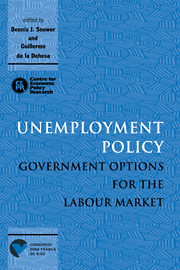Book contents
- Frontmatter
- Contents
- List of figures
- List of tables
- Preface
- Acknowledgements
- List of conference participants
- 1 Introduction
- PART ONE GENERAL POLICY ISSUES
- PART TWO DEMAND MANAGEMENT AND SUPPLY-SIDE POLICY
- PART THREE SUBSIDISING EMPLOYMENT AND TRAINING
- PART FOUR LABOUR MARKET REGULATIONS
- PART FIVE POLICY, JOB REALLOCATION AND THE UNEMPLOYMENT–PRODUCTIVITY RELATION
- 14 Is there a trade-off between unemployment and productivity growth?
- Discussion
- 15 Gross job reallocation and labour market policy
- Discussion
- Discussion
- PART SIX COMPARING UNEMPLOYMENT POLICIES
- Index
15 - Gross job reallocation and labour market policy
Published online by Cambridge University Press: 07 September 2010
- Frontmatter
- Contents
- List of figures
- List of tables
- Preface
- Acknowledgements
- List of conference participants
- 1 Introduction
- PART ONE GENERAL POLICY ISSUES
- PART TWO DEMAND MANAGEMENT AND SUPPLY-SIDE POLICY
- PART THREE SUBSIDISING EMPLOYMENT AND TRAINING
- PART FOUR LABOUR MARKET REGULATIONS
- PART FIVE POLICY, JOB REALLOCATION AND THE UNEMPLOYMENT–PRODUCTIVITY RELATION
- 14 Is there a trade-off between unemployment and productivity growth?
- Discussion
- 15 Gross job reallocation and labour market policy
- Discussion
- Discussion
- PART SIX COMPARING UNEMPLOYMENT POLICIES
- Index
Summary
The popularity of the notion of ‘labour market flexibility’ in the policy debate in Europe and the interest in sectoral reallocations as a source of the business cycle in the USA, have led to the accumulation of statistical information on job reallocations in several OECD countries. The manufacturing data gathered by Davis and Haltiwanger (1992) in the USA have been particularly influential. Davis and Haltiwanger found that a large number of jobs close down each quarter and an equally large number open up, apparently for specific reasons unrelated to sector or economy-wide performance. When the OECD (1994) compiled comparable data for several of its members, it found that the US experience was by no means exceptional, though it also found that job reallocations elsewhere were on average not as frequent.
Concurrently with the collection of data for the OECD, a number of authors have developed theoretical models to explain the processes of job creation and job destruction. A natural way to think about job creation is in terms of the matching of job-seekers with hiring firms, along the lines of the equilibrium search literature. The search literature, however, had only a rudimentary discussion of job destruction and several suggestions have been put forward about the factors underlying the destruction process. In the analysis of Mortensen and Pissarides (1994) jobs differ according to productivity and job destruction takes place when the productivity of a job, following a shock, drops below a reservation value.
- Type
- Chapter
- Information
- Unemployment PolicyGovernment Options for the Labour Market, pp. 467 - 489Publisher: Cambridge University PressPrint publication year: 1997
- 8
- Cited by

